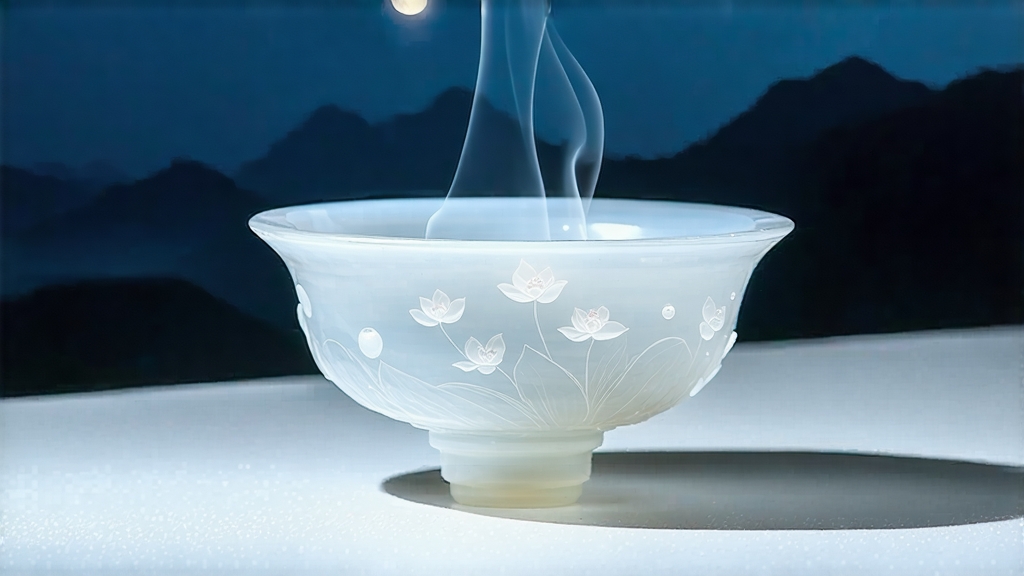
If green tea is the youthful scholar of Chinese tea culture and pu-erh the venerable sage, then Bai Hao Yin Zhen—Silver Needle—must be the moonlit poet who arrives unannounced, speaks in whispers, and vanishes before dawn. Among all white teas, none carries a more misleading name: the “needle” is not steel but the single, down-covered bud plucked just as the mountain dew begins to lift; the “silver” is not metal but the microscopic trichomes that catch light like frost on a spider’s web. To hold a gram of Yin Zhen is to hold a piece of spring night itself, cool, weightless, and faintly luminous.
Origin stories cluster around Yin Zhen like moths around a lantern. The most often repeated begins in 1796 on the northern flanks of the Taimu Mountains near Fuding, where a tea gardener named Wei Yin noticed that unopened buds, accidentally left overnight on a bamboo tray, had lost their grassy edge and acquired a mellow, almost honeyed quietude. Rather than discarding the “ruined” leaves, he dried them gently the next morning; the local magistrate, served the infusion by chance, declared it “a liquor of liquid moonlight.” Whether myth or memory, the anecdote captures the essential philosophy of white tea: minimal interference, maximum listening.
True Silver Needle is stubbornly local. National standards permit only two micro-regions to claim the name: Fuding in northern Fujian and Zhenghe in the interior, where red-clay soils, subtropical humidity, and a 1,200-meter elevation conspire to slow the bud’s growth, packing it with amino acids while keeping tannins low. Within these zones, only the Da Bai and Da Hao cultivars—literally “Big White” and “Big Down”—are recognized, their buds plump enough to yield the signature needle shape after withering. Attempts to transplant the cultivar to Yunnan or Sri Lanka have produced pleasant teas, but the buds refuse to stand upright in the cup; they slump, betraying their foreign terroir.
The picking window is brutally short: three, at most five, days in late March when the bud reaches 2.5–3 cm but has not yet unfurled into a leaf. Experienced pickers work by moonlight, believing that cooler temperatures keep enzymatic activity low and preserve the bud’s intrinsic sweetness. A single kilo of finished tea demands between 30,000 and 40,000 buds, all plucked with the nail, not the fingertip, to avoid bruising. The day’s harvest must reach the withering shed before the mountain sun climbs above the pine ridge; any delay traps grassy aromatics that no amount of later coaxing can dispel.
Withering is where science dissolves into meditation. Traditionally, buds are laid two fingers deep on bamboo trays stacked like hollow pagodas inside a drafty loft. For 36–48 hours they rest in ambient air of 22–28 °C and 65–75 % humidity while enzymatic oxidation tiptoes forward at glacial speed. Every two hours the tea master lifts a tray, tilts it, and listens: the rustle should sound like silk, not cardboard. When the bud’s moisture drops to 10–13 %, a final low-temperature bake—never above 40 °C—locks in fragrance without caramelizing sugars. The result is a tea that is neither green nor fully oxidized, occupying a liminal category the Chinese call “alive but sleeping.”
Judging finished Silver Needle is a tactile pleasure. Hold a bud against a matte black card: the down should stand perpendicular to the axis, forming a continuous silvery sleeve. Snap it; the fracture should be clean, exposing a micro-dot of pale green. Drop five buds into a warmed glass; they should clink softly, like porcelain beads. Inferior lots appear grey rather than silver, the trichomes patchy or rubbed off by rough handling. A faint scent of fresh lychee should linger above the dry leaf; any hint of hay or parched rice signals over-long withering or storage in a humid warehouse.
Water choice is non-negotiable. Yin Zhen’s delicacy will magnify every mineral note, so reverse-osmosis water left overnight in an open clay jar to re-oxygenate